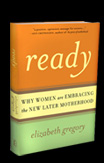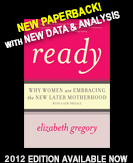About this book • Read an excerpt • read reviews • fast facts
Ready: why women are embracing the new later motherhood
About this book
In her book Ready: Why Women Are Embracing the New Later Motherhood, Elizabeth Gregory explores the background to the trend to starting families at or after 35 by birth or adoption, and its effect on individual women, their families and the wider world. Recognizing that the global trend to starting families later creates huge changes for everyone, and that very little research had been done on the causes and effects of this shift, Gregory started a study. Ready draws on her interviews with 113 new later moms (and a few dads) and on her extensive collateral research in national databases. It turns out that the new pattern creates many dynamic ripple effects for individuals and for society, some negative and many very positive. The national media have tended to focus on the individual and on the negative, leaving us with a skewed sense of what's going on and what's at stake.
Over the past four decades, ever since hormonal birth control became widely available, women around the world have been delaying the start of their families beyond the ages when their mothers had their first children and reducing the total number of their kids. As part of this trend, skyrocketing numbers of women have chosen to start their families in their late thirties and early forties, and some even later. In 2007, ten times as many women had their first child between the ages of 35 and 39 as in 1975, and thirteen times as many had their first between 40 and 44. Add in the adoptive moms, and you've got a substantial group.
In Ready, Gregory tracks the burgeoning trend of new later motherhood and demonstrates that for many women today, waiting for family works best—both personally and in its wider social effect since it links to an increased status in policy debates for women as a group. Without ignoring the complexities that older women may face in their quest to have children, she provides compelling evidence of the many benefits of starting families later —by birth or by adoption. Gregory reveals that large numbers of women succeed in having children between 35 and 44 by the usual means (one in seven kids born today has a mom in that age range), and that many of those who don’t succeed nonetheless find alternate routes to happy families via egg donation or adoption. And they’re glad they waited.
The Benefits of Waiting
Stronger family focus: Having achieved many of their personal and career goals, new later moms feel ready to focus on family rather than trying to juggle priorities.
More financial power: New later moms have established careers and make higher salaries on average.
Greater self-confidence: New later moms have more career experience, and their management skills translate directly into managing a household and advocating for their children.
More stable single-parenting: New later moms who are single have more resources.
More flexibility: New later mothers have often advanced enough at work to have the clout that allows them to negotiate work schedules that accommodate family.
High marriage rate: On average, 85 percent of new later moms are married, lending stability to the family structure. Many women wait on purpose to find the right partner for the long-term.
Higher Education: Sixty percent of later moms having their first child in 2003 had a BA or higher, compared with just 26 percent of all moms giving birth in that year.
Rising Class: Though many new later moms are middle class, not all of them started out there; when working-class women pursue education and establish themselves in jobs before they start their families, they may wind up rearing middle-class children.
Greater Likelihood of Happiness in Marriage: Higher salaries, job skills, and savings create a safety net so that women don’t have to stay in unhappy marriages to avoid impoverishing their kids, and having assurance that you can leave is sometimes the best insurance that you won’t want to.
Peer Marriages: Peer marriages bring together “equal companions” who have similar education levels and job experience and who contribute similarly in all areas within the marriage.
Younger Husbands: Close to 80 percent of married women who have their first child in their twenties have older husbands. But only about 60 percent of new later moms are married to older men—approaching the 50/50 division that would result if social
convention played no role. This change has many positive repercussions, including, for example, an increased chance that husbands will live to be their wives’ companions in old age (since men die younger than women on average).
Longer Lives: Evidence indicates that new later moms actually live longer than moms who start their families earlier.
Shadow Benefits System: Absent a social support network for parents, the new later motherhood supplies the tools (like clout and higher pay) with which many moms build their own shadow benefits systems at work.
Trickle Up: Delay of kids, which links to higher education and establishment at work, also connects to women’s movement upward (still a trickle, but faster than it would be otherwise) into the upper ranks of management in business and government, where they can affect policy.
The Drawbacks
Greater Chance of Infertility: The chances of infertility increase with age, especially after 40. This is a real issue but it’s overplayed in the media, and the complexity lies in looking at the facts to figure out your risk and your priorities (see chapter 6). Although infertility may block the usual road to family, many people find alternate routes to that happy ending.
Families May Be Smaller Than Desired: While some couples choose to have only one or two children, others stop there by default.
Risk of Less Grandparent Involvement: The older the parents, the older the grandparents.
Lower Energy: Greater age can mean lower energy levels, but many new later parents respond by making the effort to stay fit and active.
Ready looks at the big picture and shatters the myths surrounding later motherhood. Drawing on both the statistical evidence and the voices of the new later mothers themselves, Gregory delivers surprising and welcome news that will revolutionize the way we think about motherhood.
About this book • Read an excerpt • read reviews • fast facts



